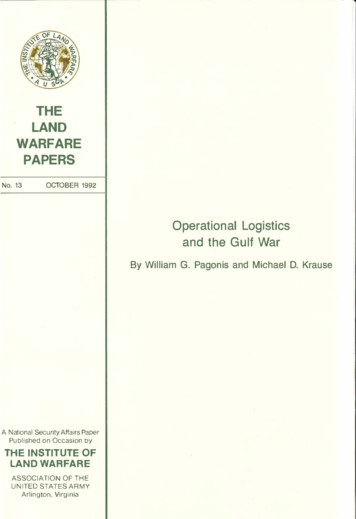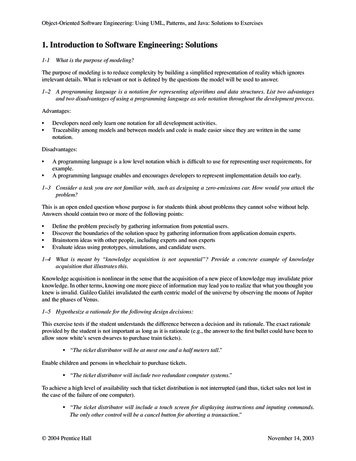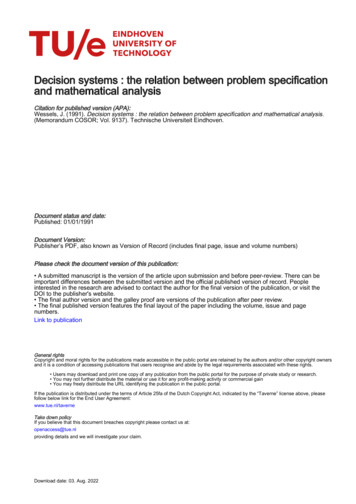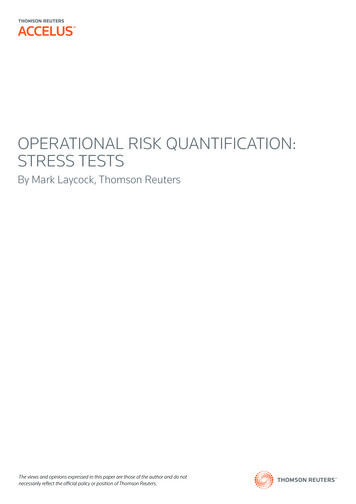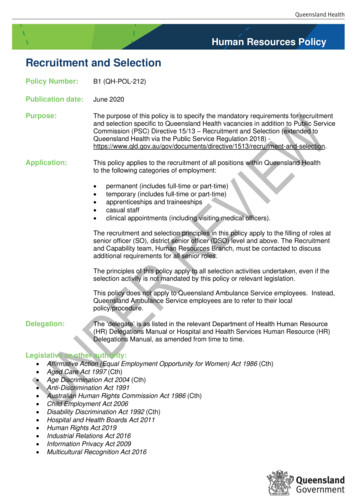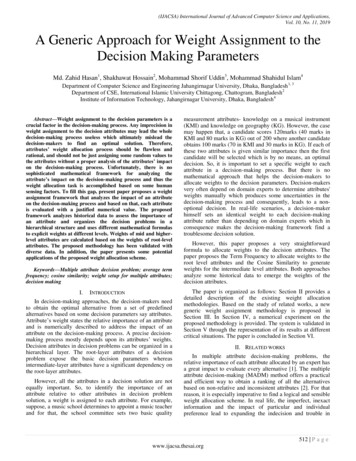
Transcription
IBM SoftwareIntelligent Business Process ManagementTaking Operational DecisionManagement to the Next LevelTaking Operational DecisionManagement to the Next LevelRecognize opportunity and risk - and act in context with data todrive digital transformation
2Accelerate Customer EngagementsContents3 Introduction4 ODM: Next generation decision management- Making decisions in context- Making decisions in real time5 Using next generation ODM to recognizeopportunity and risk — and act on it6 The seamless path from insight to action7 The IBM Advantage- IBM Operational Decision Manager Advanced- IBM Business Process Management
IBM Software3IntroductionThe need to elicit meaning from data and apply it to businessAnd while an example from healthcare is illustrative, the ideadecision-making has never been stronger. Today, businessesapplies more broadly to a variety of industries. Financialhave access to more data from more sources, and greaterservices, logistics, travel, entertainment, retail — all these andpotential to uncover valuable insights from it. Unlocking thismany others stand to realize significant business advantagespotential has been the challenge, especially since the valuefrom the ability to use data to uncover opportunities or risksof operational data deteriorates so quickly. Consider thatand then make operational decisions in context to grow theirthe average half-life of data for tactical decision-making isbusiness more profitably.less than 30 minutes, and in some cases is as short as sixseconds. After that, only 30 percent of data has any value.1This paper will explore why organizations across a range ofindustries need the latest Operational Decision ManagementConsider a hospital that’s trying to ensure that emergency(ODM) capabilities. New ODM solutions enable them to betterpatients never have to wait for care. While historicalidentify opportunity — and risk — and turn those insights intoinformation about emergency admissions is useful foraction to respond in the most effective ways possible.triggering decisions about staff schedules and other actionsthat can help achieve this customer-centric goal, immediateinformation adds another valuable layer of insight. Forexample, they may know that admissions tend to go up onweekend nights and plan accordingly. But what if they alsoknow that a pile-up has just happened on the interstate ona particular weekend night? That information has immediatevalue for decision-making. Taken together with othercontextual information such as the number of rooms available,the number of doctors and nurses working at different times,and the rate of patient admissions so far that day, it can beused to trigger operational decisions to optimize schedulingand staffing.This example illustrates the speed of response that’s possiblewithin a rich context that leverages historical data as well asspecific, immediate data about events that are happening ina particular time and place. By using all the sources of dataavailable today — including mobile, social, the Internet ofThings (IoT) and existing operational data — in conjunctionwith new tools that support real-time operational decisionmanagement, businesses are finally able to not only collectbig data, but also act on it in real time to improve day-to-dayoperational decisions.Figure 1. Using the latest ODM capabilities, organizations canexamine data in context to identify opportunities and risks.
4Accelerate Customer EngagementsODM: Next generation decision managementODM began as a way to automate decisions through businessrules management systems (BRMS) technology. It’s thetechnology that, for example, allows an insurance companyto dynamically generate quotes on demand by applyingbusiness rules governing eligibility, underwriting and ratingto the information customers provide when they go onlineto request information about premiums. Here, a proceduralrequest triggers a rules-based response. The capabilitiesevolved to add time-based event pattern detection(complex event processing), but managing the datapresented challenges.What’s different now is the ability to use new and moreimmediate sources of information to take business rulesmanagement and complex event processing to a higher level,bringing more dimension and precision to decision-making.This ability to leverage more information and more kindsof information about people and events enables decisionsabout those people and events in context and in real time.New constructs and tools are now available to manage andrepresent all the time-sensitive data that your business musthandle. And that makes the already considerable value ofODM even greater.Making decisions in contextWhen it comes to making the best possible business decision,it’s not always enough to know that a customer is taking aparticular action. Knowing the circumstances under whichan action is occurring — in other words, the context for thebehavior — can be just as important, if not more so.Today, the world is full of sources of contextual information,from mobile devices to social media to IoT devices. AndODM today is about using analytics to find patterns in thatinformation, uncovering insights that will identify opportunitiesand risks, and improving the decision-making process. Forthe first time, there’s the potential to be proactive and makeoperational business decisions in context.A financial institution, for example, could use next generationODM to track how customers navigate through articles on thecompany’s investments web page. What are they reading?What were they reading before? What’s changed? There willbe many, many data points that inform and enrich the contextthat drives customer behavior, and detecting these behaviorchanges opens up new opportunities to engage the customer.ODM can help identify not only opportunity, but also risk. Inanother area of bank operations, a financial institution coulduse ODM to more accurately detect possible credit-cardfraud faster. The key is the ability to use evolving contextualinformation to identify new situations for which the bank canflexibly create and deploy new rules that quickly detect theseadditional fraud threats and trigger appropriate action such asblocking transactions. Successful fraud detection hinges onthe quality of data and time sensitive decision-making. Twoout of three credit card fraud alerts turn out to be legitimatecustomer purchases, and blocking these simply annoys thecustomer.2 But with ODM, the future is wide open to changethe game on this critical metric.Making decisions in real timeThe example of the hospital emergency room at the beginningof this paper calls attention to another important aspectof context: time. If ten patients have arrived in the waitingroom at a time when one or two would be the norm, thattells decision makers they need to adapt to accommodatethe change in demand before it becomes a challenge forresources. In this type of situation, historical information willhelp establish baselines for action, but real-time data is anessential part of the equation.Similarly, if a retail customer is in a store, able to make apurchase, that’s the time to act; a report that the customerwas in the store three days ago doesn’t have value in thesame way. A decision made in context means a decisionmade in light of complete information that includes bothhistorical and immediate information. It also means a decisionmade in a way that will drive the organization toward abusiness goal — whether that means increased efficiency,improved customer satisfaction, more conversions or sales,or some other measure of achievement.
IBM SoftwareUsing next generation ODM to recognizeopportunity and risk — and act on itNext generation ODM today can deliver the ability to1) understand data in context, 2) apply analytics to it toidentify opportunity or risk and 3) make an informed decisionabout how to act on it. Taking that action is the next essentialstep. After all, recognizing an opportunity is one thing, butseizing it is another. Once ODM has recognized a patternthat suggests opportunity or risk, one of the things theorganization can do is execute predefined business processesto take the best possible action and manage the action toconclusion.To use another example from the financial industry, consider aretail banking scenario in which the bank correlates CRM dataindicating a recent loan payoff with Twitter posts expressing acraving for a new car. The opportunity for an offer is clear; thenext step is to apply the appropriate business process to offerthe customer a vehicle loan. This scenario is a reminder, too,of the growing importance of Twitter and other social mediaas new sources of time-sensitive digital data for operationaldecision-making. Next generation ODM can handle a Twitterdata stream just as it handles all the streams of disparate datacoming in — tracking it, considering it in context with otherdata, applying predictive analytics and making better, moretargeted decisions as a result.5
6Accelerate Customer EngagementsThe seamless path from insight to actionThe key to deriving the maximum benefit from ODMtechnology today is the ability to seamlessly move throughthe decision journey — first garnering insights from data incontext, then establishing decisions based on those insightsand, finally, triggering the right business processes to carryout decisions.Without a solution that connects ODM to BPM, organizationswill find it challenging to link decision and action. Therein liesthe benefit of an integrated solution that’s designed to makethe connection between ODM and BPM systems seamlessand automatic: It can smooth the path from detecting anopportunity to triggering a business process to act on it.For example, many transportation companies face a variety offraud risks associated with fueling, ranging from diverting fuelaway from the vehicle, train or plane for which it’s intendedto using a company fuel card to refuel a personal vehicle.To control these risks, companies can use ODM to directlycompare information from streams of geolocation eventsthat show fleet activity and check it against fueling activity.If there are discrepancies that suggest fraud, the companycan follow through by making changes in how fuelingactivities are managed, such as assessing fines andwarning suppliers.Business process management (BPM) is necessary tomanage the full course of action in a scenario like the onedescribed above that may require multiple people to domultiple things over a potentially long period of time. It’s whatmakes it possible to be sure action is completely documentedand carried through.Figure 2. An integrated approach that seamlessly connectsODM and BPM makes it easy to move from collecting andassessing data to identifying opportunities and acting on them.
IBM Software7The IBM AdvantageIBM offers the entire scope of capabilities and resourcesto provide companies with the competitive advantage thatresults from customer-centric business transformation. Anunsurpassed depth and breadth of solutions comprise acomprehensive set of collaborative, role-based capabilitiesdesigned to help model, simulate, execute, change, monitorand optimize core business processes.IBM ODM Advanced has a user-friendly interface that allowsbusiness experts to write rules in natural language — notcode. They can easily and consistently implement, test anddeploy decision changes to meet new market demands andpolicy requirements. Understanding how business decisionsthat drive operations are made and applying those decisionsacross applications can reinvent business operations.IBM’s Smarter Process solution involves the infusion of everyprocess with intelligence and expertise to create a frameworkin which all processes are built around a determinationto delight the customer. With more than 5,000 customerengagements, that represent three times the install baseof the nearest competitor and 20 data centers around theworld, the IBM Smarter Process Platform offers unsurpassedcapabilities.For more information on IBM ODM Advanced, please ategory/operational-decision-managementIBM Operational Decision Manager AdvancedIBM Operational Decision Manager Advanced enablesbusiness professionals to automate and govern repeatable,day-to-day decision-making across business processesand applications, improving business insight and deliveringrelevant and personalized outcomes. The software managesbusiness logic outside of applications — reducing the relianceof business professionals on IT and empowering them tocreate and manage business rules. This empowerment allowsyou to address shifting business contexts in near real-timeand improve responsiveness and performance.Additionally, predictive analytics can be used to act upondata to anticipate business needs and beat the competition.Organizations can take advantage of the data availableto them to enrich and improve their business decisions,delivering customer-centric digital transformation. They cannow capture events, build context and apply it to operationaldecisions in near real-time. In doing so, they can detectsituations as they occur — presenting risks or opportunities— to enable action. This transformation is being led bybusiness users, bringing their skills and expertise to thoserepeatable decisions.IBM Business Process ManagementWith IBM Business Process Manager, clients have the benefitof a complete set of market-leading processing capabilitiesto optimize business operations delivered in a single,unified platform. The platform is simple enough to engageall knowledge workers and process participants, regardlessof their role or size of the project, and powerful enough toscale in support of enterprise-wide transformation. Distinctlevels of capability are designed to meet the needs of a widespectrum of clients and include broad design, developmentand governance features. Clients can start simple andexpand their infrastructure as their business grows, andIBM is the only BPM vendor that supports all styles of work,including human-centric workflow, case and straight-throughprocessing. Deployment options include on premise, publicand private cloud, and pattern deployment as part of IBMPureApplication. With the recent offering of hybrid cloudoptions, customers have access to a distinct option forsimplifying operations and reducing ownership costs.
Agreeing on TermsHere are definitions of key concepts you’ll encounter as youread through this paper. Act in context with data: To take advantage of thetremendous amount of contextual data that’s generatedaround their business, organizations must operationalize itwith real-time action. Business events: Actions, or patterns of actions, thatoccur and have relevance to the business. Business rules: Logic written in natural language thatprovides the basis for automating operational decisions. Operational decisions: Decisions that relate to the dailyoperations of the organization. They are frequent, typicallyhigh in volume and usually automatable.1. Measuring the half life of data, Nucleus Research, 20122. creditcards.com survey, 2014 Copyright IBM Corporation 2015IBM, the IBM logo and ibm.com are trademarks ofInternational Business Machines Corp., registered in manyjurisdictions worldwide. Other product and service names mightbe trademarks of IBM or other companies. A current list of IBMtrademarks is available on the Web at “Copyright and trademarkinformation” at www.ibm.com/legal/copytrade.shtmlThis document is current as of the initial date of publication andmay be changed by IBM at any time. Not all offerings are available in every country in which IBM operates.The performance data discussed herein is presented asderived under specific operating conditions. Actual resultsmay vary. It is the user’s responsibility to evaluate and verifythe operation of any other products or programs with IBMproducts and programs.THE INFORMATION IN THIS DOCUMENT IS PROVIDED “ASIS” WITHOUT ANY WARRANTY, EXPRESS OR IMPLIED,INCLUDING WITHOUT ANY WARRANTIES OF MERCHANTABILITY, FITNESS FOR A PARTICULAR PURPOSE AND ANYWARRANTY OR CONDITION OF NONINFRINGEMENT. IBMproducts are warranted according to the terms and conditionsof the agreements under which they are provided.ContributorsJames Casey, Amy Dickson, Francis Friedlander, David Millen,Vijay Pandiarajan, Aali Qureshi, Melanie Ratchford, DanielSelmanSTW12345-USEN-00
IBM oftare 5 Using next generation ODM to recognize opportunity and risk — and act on it Next generation ODM today can deliver the ability to 1) understand data in context, 2) apply analytics to it to identify opportunity or risk and 3) make an informed decision about how to act on it. Taking that action is the next essential step.
